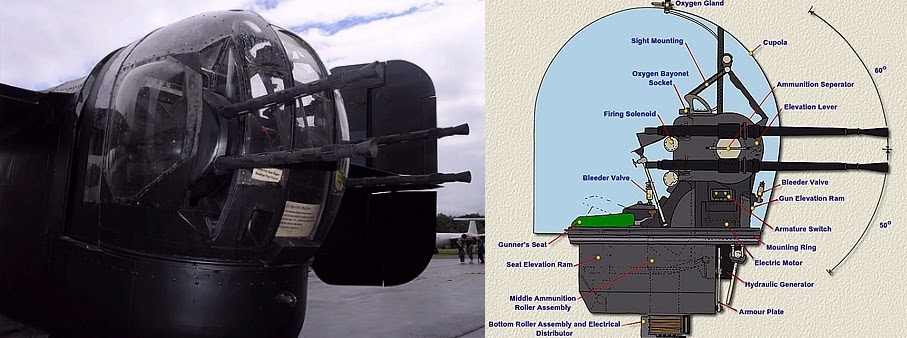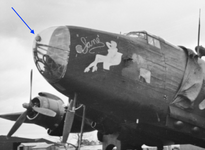Navigation
Install the app
How to install the app on iOS
Follow along with the video below to see how to install our site as a web app on your home screen.
Note: This feature may not be available in some browsers.
More options
You are using an out of date browser. It may not display this or other websites correctly.
You should upgrade or use an alternative browser.
You should upgrade or use an alternative browser.
Questions about HP Halifax III
- Thread starter Pienske
- Start date
Ad: This forum contains affiliate links to products on Amazon and eBay. More information in Terms and rules
More options
Who Replied?Airframes
Benevolens Magister
Looks like the infra red I.D. lamps use from late 1944, to "illuminate" and ID. the aircraft to other "friendlies" equipped with AGLT and IR warning rear turret, ( and I'm ashamed to say I've temporarily forgotten its name !! ).
- Thread starter
- #3
Hello,
The HP Halifax had a tail turret with 4 .303 guns. The ammunition for these guns was located in boxes inside de center fuselage of the plane.
Via some rails was where the bullets fed to the turret.
But how did these bullets arrive at the guns themself, since you have a moving turret...?
Are there any schematic drawings are cutaways that can explain the mechanism?
Thanks a lot for your help.
Kind regards
The HP Halifax had a tail turret with 4 .303 guns. The ammunition for these guns was located in boxes inside de center fuselage of the plane.
Via some rails was where the bullets fed to the turret.
But how did these bullets arrive at the guns themself, since you have a moving turret...?
Are there any schematic drawings are cutaways that can explain the mechanism?
Thanks a lot for your help.
Kind regards
Airframes
Benevolens Magister
I think I have a turret diagram somewhere, but haven't a clue where !
Basically, the ammunition belts were "dragged" along the chutes into the gun feeds, when the guns were fired. A set of electro-mechanical gear cogs lifted the belts up from the chutes, with the action of the guns themselves feeding the belts through the feed pawls, just as they would on a ground-operated gun.
Basically, the ammunition belts were "dragged" along the chutes into the gun feeds, when the guns were fired. A set of electro-mechanical gear cogs lifted the belts up from the chutes, with the action of the guns themselves feeding the belts through the feed pawls, just as they would on a ground-operated gun.
See here I believe:

 tailendcharlietedchurch.wordpress.com
tailendcharlietedchurch.wordpress.com

Rear Gun Turrets
Rear Gun Turrets Halifax KN-W fellow Rear Gunner – smiling Flt Officer ‘Jock’ Jacks – RAF Elvington Station Gunnery Instructor The Halifax with the Switch to Boulton Paul T…
Hello,
Does anyone of you have an idea what these circle parts are in the nose of a Handley Page Halifax III?
There is one on each side of the nose?
Thanks for your help.
Village Inn or Type Z. Mosquito "Resin Lamps" [Archive] - PPRuNe Forums
"Research, in Kew, continues, and many files remain, but discoveries, so far, are that there were two infra-red recognition systems in use during mid/late WWII, types "Z" & "F." "Z" was used on bombers, and was not "Village Inn," though it was allied to it. "F" was used on fighters, initially just twin-engined, but later extended to some single-engined.
Findings, so far, are that "Z" included forward "firing" IR lamps, which could be picked up by the tailgunner of a preceding bomber, if he had an IR scope attached to his guns.
The exact set-up of "F" still remains to be found, but, on at least two papers, in a file on both systems, there is mention of the length of time that resin lamps should be used, which tends to confirm that, by mid-to-late war, they were part of the IR set-up. The lamps were supposed to flash a Morse letter ("E" was found to be unsuitable,) which could be changed at certain intervals.
A 1942 recognition leaflet contains a section on resin lamps, with the warning that they are not to carried more than a few miles off the coast of the U.K., which also indicates that, by then, their use was now secret. It also says that some fighters are carrying them as an extra tail lamp on the trailing edge of the rudder.
"Village Inn" was a radar-equipped rear turret, which could detect enemy, and friendly, aircraft, with the gunner using the scope to interrogate them for the forward-exposing IR lamps, from a reasonable range. As well as the IR scope, V.I. included a gyro gunsight (type IIC, while fighters carried IID,) which enabled the gunner to engage an enemy at deflection angles, without the need for night vision-destroying tracer.
A friend of mine, about 20 years ago, put a request into Aeroplane Monthly, asking about resin lamps, and, at first, only got letters from former pilots, complaining about how useless they were as formation lights, because they were so dim; he finally heard from a man, still working in the industry, who told him all about the lamps and the IR scopes, which were fitted to Mosquito nightfighters but removed, and locked in a cupboard after each sortie. He also said that bomber pilots were never told of their true purpose, so that, if captured, they didn't inadvertently give away the information."
Last edited by a moderator:
- Thread starter
- #7
What does the AGLT mean?Looks like the infra red I.D. lamps use from late 1944, to "illuminate" and ID. the aircraft to other "friendlies" equipped with AGLT and IR warning rear turret, ( and I'm ashamed to say I've temporarily forgotten its name !! ).
- Thread starter
- #8
Would be great to have that diagramI think I have a turret diagram somewhere, but haven't a clue where !
Basically, the ammunition belts were "dragged" along the chutes into the gun feeds, when the guns were fired. A set of electro-mechanical gear cogs lifted the belts up from the chutes, with the action of the guns themselves feeding the belts through the feed pawls, just as they would on a ground-operated gun.
I think you will find that they are in the first response I gave earlier up this threadWould be great to have that diagram.
- Thread starter
- #11
Thanks a lot for the help.I think you will find that they are in the first response I gave earlier up this thread
If I understand it well... in these 2 circles there were some lamps - Infra Red lamps - installed that then were detected by the rear turret gunner of another plane with a special kind of device. That allowed the rear gunner to "see" that the plane he saw was not an enemy plane. Do I get it right?
Last edited:
Users who are viewing this thread
Total: 1 (members: 0, guests: 1)

